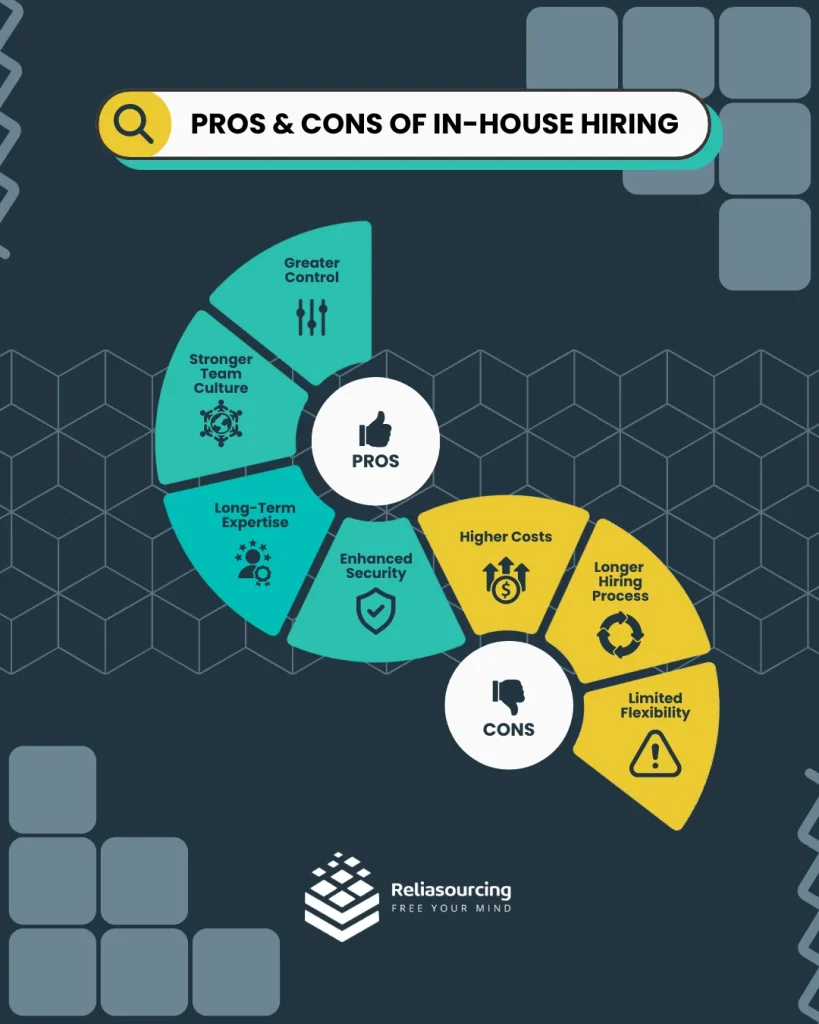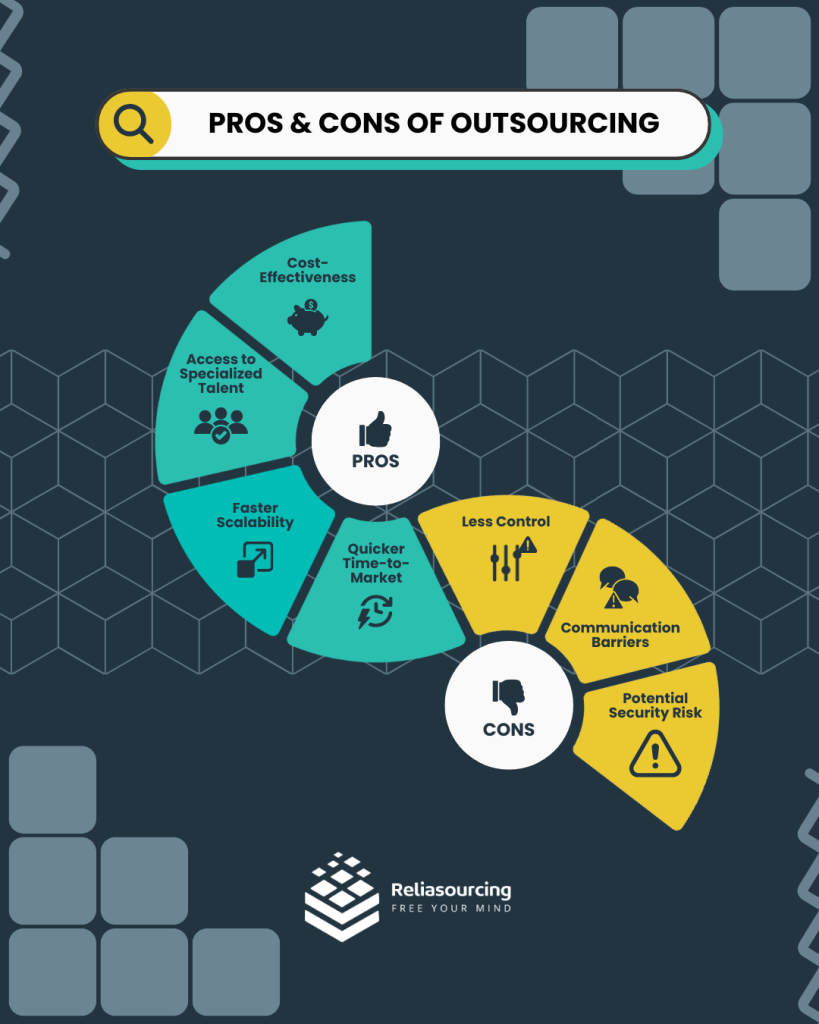What is In-House Hiring?
When comparing in-house vs. outsourcing, one has to know what both terms mean. In-house hiring refers to the process of building and managing a team of employees within your company. These employees are directly hired, trained, and managed by your organization and work exclusively on your business operations.
For example, a mid-sized software company developing a proprietary platform may choose to build an in-house development team to maintain tight control over product quality and intellectual property. Hiring full-time developers, designers, and QA specialists enables the company to ensure seamless collaboration, foster a strong team culture, and retain institutional knowledge that supports ongoing innovation and long-term product evolution.

Pros of In-House Hiring
- Greater Control – Businesses directly oversee their teams, ensuring that projects align with internal strategies and standards. This level of control enables more immediate adjustments, consistency in processes, and alignment with long-term objectives.
- Stronger Team Culture – In-house employees are immersed in the company culture, leading to better collaboration and alignment with business goals. This results in stronger employee engagement, loyalty, and a shared sense of purpose that enhances team performance.
- Long-Term Expertise – Investing in an in-house team builds institutional knowledge over time, making it easier to maintain and improve processes. These employees accumulate experience that becomes a strategic asset, especially for complex and evolving operations.
- Enhanced Security – With all operations managed internally, businesses have greater control over sensitive data and intellectual property. This minimizes risks associated with data breaches and ensures compliance with internal policies and industry regulations.
Cons of In-House Hiring
- Higher Costs – Hiring full-time employees requires competitive salaries, benefits, office space, and infrastructure. These ongoing expenses can be a strain on budgets, particularly for small or growing businesses.
- Longer Hiring Process – Recruiting the right talent can take weeks or months, delaying project execution. The time spent on job postings, interviews, onboarding, and training adds to operational lag.
- Limited Flexibility – Scaling an in-house team up or down is challenging due to employment contracts and operational commitments. Businesses may find it difficult to adapt quickly to market shifts or seasonal changes in demand.
While in-house hiring offers control, cultural alignment, and long-term expertise, it comes with increased costs, a slower hiring process, and less flexibility. Businesses must assess their priorities and resources to determine whether an internal team best supports their growth and operational objectives.
What is Outsourcing?
Outsourcing involves delegating specific business functions to external professionals, firms, or agencies rather than handling them internally. Companies can choose from various outsourcing models, including freelancers for individual tasks, specialized firms for comprehensive solutions, and offshore teams for cost-efficient operations across different time zones. This strategy allows businesses to focus on core activities while leveraging external expertise to enhance efficiency and scalability.

Pros of Outsourcing
- Cost-Effectiveness – Outsourcing eliminates salaries, office space, and training expenses, significantly reducing operational costs.
- Access to Specialized Talent – Businesses can tap into a global talent pool, finding experts with niche skills quickly.
- Faster Scalability – Companies can rapidly expand or reduce teams based on project requirements without the constraints of hiring and layoffs.
- Quicker Time-to-Market – Outsourced teams are often pre-trained professionals who can start working immediately, speeding up project completion.
Cons of Outsourcing
- Less Control – Since outsourced teams operate independently, businesses may have limited oversight over day-to-day operations.
- Communication Barriers – Time zone differences, language gaps, and cultural differences may affect collaboration and workflow.
- Potential Security Risks – Sharing confidential data with third parties requires strict security measures to protect intellectual property.
Outsourcing offers cost savings, scalability, and access to specialized expertise. However, it also comes with challenges such as reduced control and potential security risks. Companies must carefully evaluate their specific needs, balancing cost-effectiveness with operational oversight, to determine whether outsourcing aligns with their long-term strategic goals.
Key Factors to Consider: In-House vs. Outsourcing
Deciding between in-house hiring and outsourcing requires a thorough evaluation of multiple factors. Cost, expertise, scalability, efficiency, and control all play crucial roles in determining the best strategy for your business. Below, we compare these key aspects to help you make an informed decision.
Cost Analysis
Cost is a significant factor in the decision-making process. While outsourcing is often seen as a cost-cutting measure, it can also be a revenue-generating strategy by unlocking specialized expertise and increasing efficiency.
- In-House: Building an in-house team involves high fixed costs—salaries, benefits, office space, and recruitment. As of May 2025, the average annual salary for a mid-level graphic designer in the U.S. is approximately $71,643, with a typical range between $53,000 and $82,000. Despite the expense, in-house teams offer long-term value through cultural alignment and operational continuity.
- Outsourcing: Businesses only pay for services rendered, making it cost-effective. In the Philippines, freelance graphic designers charge an average of ₱191.38 per hour (approximately $3.40). Monthly salaries for full-time graphic designers range between ₱25,000 ($430) and ₱37,250 ($641). Outsourcing enables access to skilled creatives without long-term overhead.
Choosing between in-house and outsourcing depends on strategic priorities. In-house teams offer tighter integration, greater control over brand voice, and long-term team development. On the other hand, outsourcing provides scalability, access to global talent, and operational flexibility with up to 70% cost savings, making it ideal for companies needing rapid execution or specialized skills without the burden of full-time commitments.
Quality & Expertise
Any business’s success relies on the quality and expertise of its workforce. Whether building an in-house team or outsourcing, companies must ensure they have access to the right skill sets.
- In-House: Employees develop deep knowledge of company operations but may require ongoing training to stay updated with industry trends.
- Outsourcing: Provides immediate access to seasoned experts who bring specialized knowledge and industry best practices without requiring additional training investments.
Both models offer strong talent potential but differing benefits: in-house teams build long-term expertise tied closely to your operations, while outsourcing gives you faster access to specialized professionals already at the top of their game. The right choice depends on whether your business values internal continuity or external innovation and flexibility more.
Scalability & Flexibility
Businesses need the ability to adapt to changing demands. Scalability and flexibility determine how quickly a company can adjust its workforce based on evolving operational needs.
- In-House: Hiring and layoffs take time, involve legal considerations, and may not allow for rapid adjustments in workforce size.
- Outsourcing: Companies can quickly scale up or down based on project needs, making it a flexible solution for businesses facing fluctuating demands.
Outsourcing provides greater agility for organizations responding to short-term spikes or shifting priorities, while in-house teams offer stability but less responsiveness. Companies must assess whether they need consistent internal capacity or the ability to flex quickly based on demand.
Time & Efficiency
Efficiency and time management are critical for businesses striving to remain competitive. Outsourcing offers a faster approach, while in-house teams may require longer onboarding and training.
- In-House: Recruitment, training, and onboarding extend project timelines, delaying the start of critical operations. While this process supports strong cultural fit and smoother collaboration in the long run, it lacks the immediacy of outsourced teams. In-house onboarding remains ideal for roles requiring close integration with internal teams and proprietary workflows.
- Outsourcing: Teams are ready to work immediately, accelerating execution and reducing time to market for products and services. Additionally, offshore outsourcing allows businesses to operate across different time zones, enabling 24/7 productivity. Tasks can be completed overnight, meaning projects progress even outside of local business hours, maximizing efficiency and maintaining continuous momentum.
Companies prioritizing tight integration may prefer in-house processes, while those aiming for rapid execution and 24/7 workflows can benefit greatly from offshore outsourcing. The key is aligning your team structure with the speed and scale your goals demand.
Control & Security
Maintaining control and security is a top priority for businesses handling sensitive data and proprietary processes. In this regard, in-house and outsourcing solutions present distinct challenges and advantages.
- In-House: Direct oversight ensures greater security, better adherence to internal protocols, and alignment with business goals.
- Outsourcing: Requires strong contracts, clear communication, and compliance measures to mitigate security risks and ensure quality control.
Ultimately, the choice between in-house hiring and outsourcing depends on a company’s unique circumstances, such as budget constraints, project complexity, and long-term goals. Businesses must weigh the benefits and drawbacks of each approach to align with their operational needs and strategic vision.
To further guide decision-making, the following section outlines specific scenarios highlighting when in-house hiring or outsourcing may be the optimal choice.
When to Choose In-House vs. Outsourcing
Choosing between in-house hiring and outsourcing depends on specific business scenarios. Here are cases where each approach may be the better option.
Choosing between in-house hiring and outsourcing hinges on industry-specific needs and operational priorities. For example, tech firms may prioritize in-house development to safeguard innovation, while e-commerce or SaaS startups often seek outsourcing to scale support quickly. Here’s a closer look at when each approach best serves your business.
When In-House is Better
For businesses that require immediate, hands-on collaboration, an in-house team provides the advantage of easy communication and direct supervision. Being in the same location ensures that employees are readily available for discussions, project adjustments, and decision-making. This is especially beneficial for companies with complex workflows or industries requiring extensive oversight, such as research and development or healthcare. However, building a qualified team in-house can be expensive, particularly when hiring specialists. Budget constraints may limit the number of professionals available, leading to potential skill gaps within the company.
Product Innovation in a Tech Company:
A tech company working on a highly confidential and innovative software platform might prefer to keep all development in-house. This ensures greater control over intellectual property and enables tight coordination among cross-functional teams like product managers, designers, and engineers. For example, Apple is known for keeping its hardware and software development tightly integrated and in-house to safeguard its proprietary technology and design consistency. Face-to-face collaboration fuels innovation, allowing teams to iterate and respond to real-time feedback quickly—an approach that has helped Apple maintain its competitive edge in the consumer tech market.
High-Touch Client Services in a Law Firm:
A firm that relies on trust-based client relationships may keep legal research, case management, and client support in-house. Having dedicated legal professionals under one roof ensures client information is handled securely and consistent quality is maintained. The personalized nature of legal services benefits from close internal communication and shared institutional knowledge. For instance, According tomajor firms like Skadden, Arps, Slate, Meagher & Flom LLP are known for maintaining highly integrated in-house teams to handle sensitive corporate litigation and M&A deals, emphasizing confidentiality, consistency, and deep client engagement
When Outsourcing is Better
Outsourcing is ideal when businesses need to scale quickly and efficiently. It enables companies to bypass lengthy recruitment processes and access specialized talent globally. For example, Slack famously outsourced its app design to Canadian design firm MetaLab in its early stages, helping the company build a polished, user-friendly interface that contributed to its rapid adoption. Similarly, WhatsApp relied on developers in Eastern Europe before its acquisition by Facebook, allowing it to scale cost-effectively while focusing internal efforts on core innovation.
Outsourcing has powered thousands of businesses in the Philippines with cost-effective yet high-quality customer support. Online retailer Zappos, known for its exceptional customer service, partnered with offshore teams to sustain its rapid growth and maintain 24/7 support while preserving brand tone and consistency.
Outsourcing allows companies to stay agile, maintain competitiveness, and concentrate on revenue-generating activities without the operational demands of managing an in-house team.
Rapid Growth in an E-commerce Business:
An online retail company experiencing a sudden surge in demand during peak seasons may find outsourcing ideal for scaling customer service and logistics support. A good example is Jet.com, which partnered with outsourcing firms during its growth phase to handle high customer service volumes efficiently, especially during the holiday season. This approach helped the company maintain responsiveness and customer satisfaction while keeping internal resources focused on growth and operations. Partnering with an outsourcing provider enables businesses to manage high call volumes, process returns efficiently, and uphold service quality without putting extra strain on their core teams or investing in short-term internal staffing.
Specialized Support for a SaaS Startup:
A SaaS startup launching a new product may lack the internal resources to provide round-the-clock technical support. Outsourcing to a team of IT support specialists allows the company to offer 24/7 service coverage, tap into global technical expertise, and ensure a smooth user experience. A well-known example is Zoom Video Communications, which outsourced parts of its technical support to scale its customer service globally as usage surged during the COVID-19 pandemic. This setup freed its internal team to focus on product innovation and platform scalability.
Deciding between in-house and outsourcing requires assessing urgency and specialization and factors like control, scalability, and cost-efficiency. For instance, a tech company may opt to keep software development in-house to protect intellectual property while outsourcing customer support to maintain operational efficiency. Similarly, startups might turn to outsourcing for 24/7 technical support or seasonal e-commerce companies may scale their customer service through third-party providers.
These examples demonstrate that outsourcing is often the best option when speed, specialized talent, and operational flexibility are priorities. It allows internal teams to focus on core initiatives while outsourcing partners efficiently handle high-volume or niche tasks.
Frequently Asked Questions
Is outsourcing cheaper than hiring in-house?
Outsourcing can be significantly cheaper or cut costs than hiring in-house, primarily due to lower labor costs in offshore markets and the absence of expenses related to recruitment, training, benefits, and infrastructure.
For example, companies outsourcing to the Philippines can save up to 70% on operational costs compared to maintaining an in-house team in the U.S. These savings come not from avoiding costs altogether, but from transferring them to an outsourcing partner who manages them more efficiently at scale.
What are the most significant risks of outsourcing?
The most significant potential risks of outsourcing include data security, miscommunication, and limited oversight.
A reputable outsourcing partner addresses these by implementing strict data protection protocols (such as ISO-certified systems), offering clear communication channels with local account managers, and using real-time reporting tools that ensure visibility and control over outsourced teams. These safeguards reduce exposure while maintaining quality and alignment with business goals.
How do I transition from in-house hiring to outsourcing?
The transition from in-house hiring to outsourcing can start by outsourcing non-core tasks, ensuring clear contracts, and using collaboration tools for seamless integration.
What are the best strategies to manage outsourced teams?
One of the best strategies to manage outsourced teams is to use project management tools, set clear expectations, and maintain regular communication to ensure accountability.
How does outsourcing affect intellectual property security?
Outsourcing affects intellectual property security by introducing risks when sensitive data or proprietary tools are shared with external vendors. These risks include unclear ownership clauses, weak NDAs, and insufficient cybersecurity. If contracts don’t clearly define IP rights, vendors may claim co-ownership. Vendors in jurisdictions with weak IP laws can also complicate enforcement.
To reduce risks, companies should perform due diligence, use strong legal agreements, and choose providers with proven data security practices. Clear ownership clauses and confidentiality terms help protect your assets when working with third parties.
What are the best countries for outsourcing?
Some of the best countries for outsourcing include the Philippines, India, Poland, and Ukraine, known for cost-effectiveness and skilled talent. The Philippines stands out due to its workforce possessing strong English skills, a deep understanding of Western culture, and extensive BPO experience.
How do I maintain quality control when outsourcing?
To maintain quality control in outsourcing, the best course of action is to implement clear KPIs, conduct regular performance reviews, and support open communication with outsourced teams.
Is outsourcing a good option for startups?
Yes, outsourcing is a good option for startups, especially when considering the budget constraints they commonly face. Outsourcing enables startups to access specialized skills, reduce costs, and scale operations efficiently without the considerable financial burden of hiring a full in-house team.
Why You Should Consider Reliasourcing’s Outsourcing Solutions
Reliasourcing is an emerging leader in outsourcing solutions, catering to industries such as FinTech, Gaming & Entertainment, E-commerce, and SaaS. Its approach prioritizes tailor-made solutions, aligning workforce strategies with business objectives for optimized efficiency and scalability.
Through managed outsourcing services, Reliasourcing enables organizations to access specialized knowledge without incurring the cost of internal hires. Clients benefit from workforce management solutions, including recruitment, training, payroll, compliance, and benefits administration, streamlining operations while maintaining agility.
Why Reliasourcing Is an Effective Outsourcing Partner
- Tailor-Made Strategies: Customized solutions ensure businesses only pay for what they need, improving cost-efficiency and performance.
- Rapid Scalability: Flexible resourcing allows clients to scale teams up or down in response to growth or market demands.
- End-to-End Support: Comprehensive services include recruitment, onboarding, training, compliance, and benefits management.
- Localized Expertise: Deep operational experience in the Philippines enables seamless integration with Western businesses.
- Employee Retention: Strong focus on team engagement and professional growth, resulting in lower turnover and better service consistency.
- Operational Transparency: Clients receive regular performance updates, direct communication with team leaders, and real-time visibility.
Businesses partnering with Reliasourcing unlock a decisive edge, seamlessly scaling their operations while maintaining focus on innovation and growth. Discover how Reliasourcing’s tailored outsourcing solutions can transform your business. Explore our services and take the next step toward smarter, leaner operations. Connect with outsourcing experts today!
The Bottom Line: In-House vs. Outsourcing
A well-structured workforce strategy is crucial for business success. This article has examined the advantages and limitations of in-house hiring and outsourcing, highlighting key factors such as cost efficiency, expertise, scalability, and security. While in-house teams offer direct control and cultural integration, outsourcing provides flexibility, specialized talent, and significant cost advantages.
Organizations seeking to enhance operational efficiency, drive profitability, and remain competitive in a dynamic market stand to gain the most from outsourcing. Strategic outsourcing solutions empower businesses to scale effectively, focus on core competencies, and optimize resource allocation, making it a superior choice for sustainable growth.









